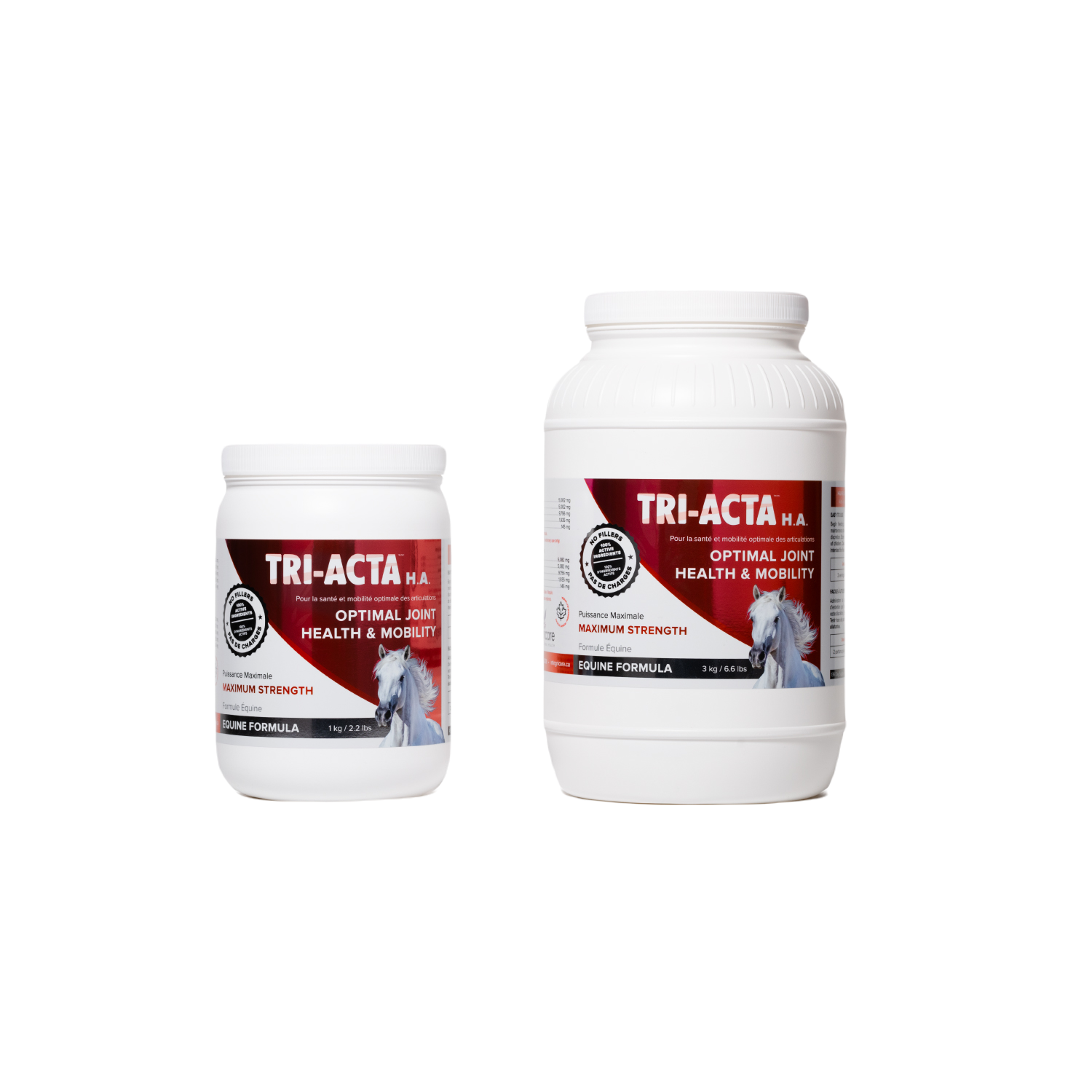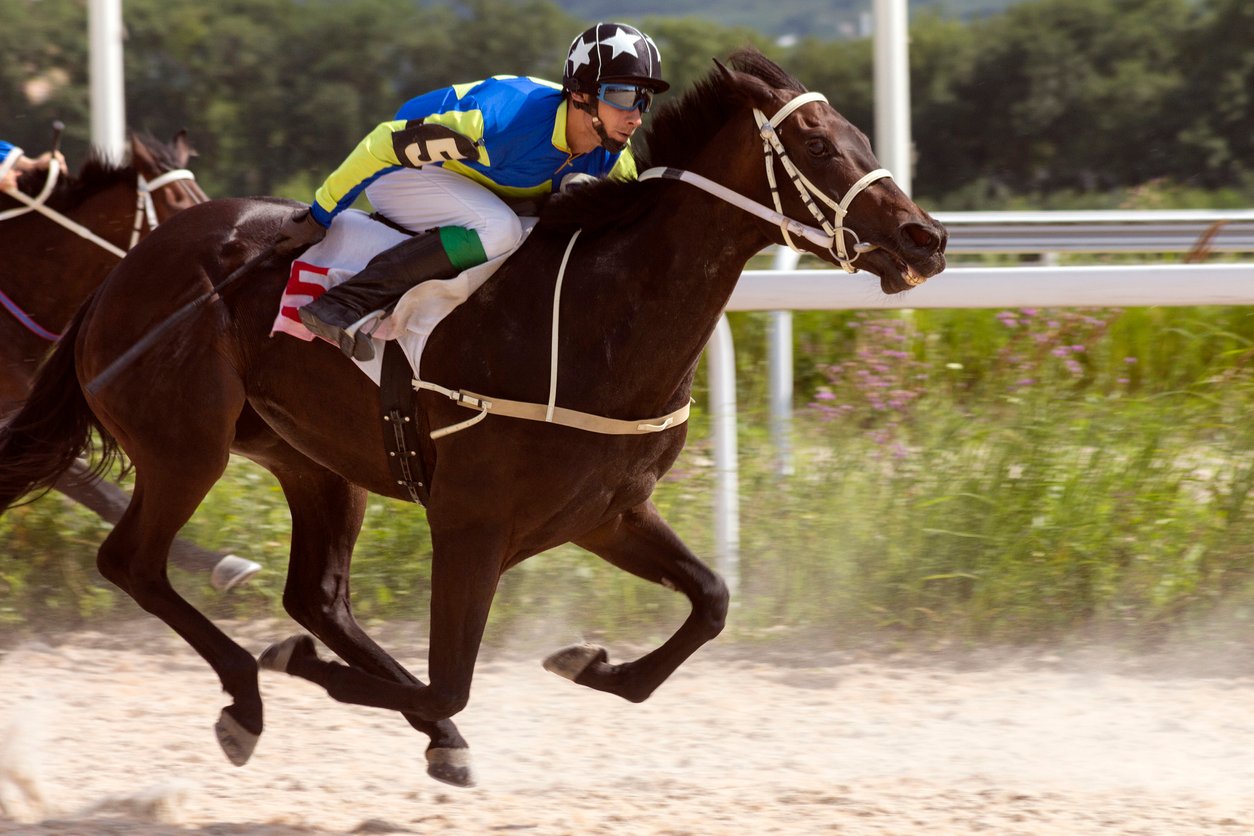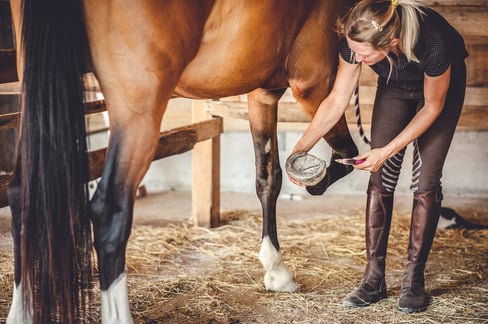Table of Contents
It’s just you and your horse riding on a warm Summer evening with a light breeze taking away the sting of the day’s heat. Some say there’s nothing better in this world.
But one sport that could possibly top that feeling is racing.
While there are many different types of horse trainers, every athlete in the race horse world has a dedicated trainer that is responsible for making sure that your horse is ready to race. This individual should be able to develop a program that focuses on the psychological response of your horse just as much as the physical—when your horse feels more confident and has a greater desire to perform, they will perform better.
In this article, we uncover what you need to know to choose the right race horse trainer for your prized equine.
TRI-ACTA H.A. for Equine
Our maximum strength formula is perfect for horses that are ageing, experiencing arthritis and stiffness, are in training and competition, or under a heavy workload.

What Does a Horse Trainer Do?
Aside from the obvious fact that a horse trainer is someone who works with horses and gets them ready for rides, shows, or racing, a horse trainer is also expected to have the ability to analyze a horse’s disposition (personality, character, and temperament). For the purposes of this article, we’ll focus on the responsibilities of a race horse trainer and what they need to do to get your horse psychologically and physically ready for racing.
When it comes to knowing how to train a horse, a race horse trainer is an essential partner for the rider and the equine. Their responsibility for the performance and health of the race horse cannot be overstated. Race horse trainers make the day-to-day decisions regarding the care and attention of a racehorse, including its exercise schedule, diet, and of course overall training to ensure that the animal is in peak performance condition for race day.
A horse trainer should also be able to recognize horse health issues and be able to advise when it’s necessary to call the veterinarian for further evaluation.
In addition to health, a horse trainer is responsible for determining which races a horse will enter alongside the horse’s owner and other expert representatives. Obviously, the horse trainer should recommend races where the horse has the highest chance of success. To be able to make effective recommendations, the horse trainer must build a strategy for the racing season and craft a training plan that supports that strategy, while keeping in close contact with the horse’s owner(s) regarding progress.
On race day, the horse trainer will oversee final preparations to ensure that the horse is ready to race. They’ll also advise Jockeys on tactics they should use to encourage the best performance out of the horse they are riding. Sometimes, a horse trainer will walk the track to make an assessment of the area, taking note of track conditions including the channel of ground, and using that information to let Jockeys know where they may be able to gain an advantage, while at the same time considering the horse’s fitness level.
Race Horse Conditioning
When a horse trainer is conditioning your horse, they should focus on every aspect of your horse’s body to prepare them for high-intensity horse racing. Good conditioning should consider:
- Respiratory: Increased oxygen uptake alongside decreased ventilation during exercise.
- Cardiovascular: Three things should be noted that indicate improvement in your horse during exercise: lower heart rate (means your horse tolerates the exercise well), increased vascularity, and increased total red blood cell volume (for carrying oxygen throughout the body effectively).
- Muscles: When the muscles are trained effectively, it gives your horse’s body more time before lactic acid accumulation and fatigue set in. Of course, when muscles are worked, they will increase in size and strength.
- Tendons, Ligaments, and Joints: The strength and quality of these structures must be maintained for your horse to perform well. TRI-ACTA H.A. is recommended for race horses because of their high activity level. In addition to two types of glucosamine for horses (glucosamine sulfate and HCl), the supplement includes hyaluronic acid, which thickens the synovial fluid in your horse’s joints, allowing for easier movement.
- Bones: Effective training results in reduced bone turnover, as well as increased quantity, quality, and geometry of bone.
- Thermoregulation: The ability of your horse to maintain an ideal core temperature even during heavy exercise can be achieved through proper conditioning, preventing serious issues like heat stroke in horses and seizures.
While measuring the horse’s condition using the points above, a good horse trainer must facilitate a careful balance of preparation and conditioning for each race your horse participates in. This ensures your horse is ready every time they enter the race track. Most horse experts recommend that a thoroughbred racehorse takes a 2–4 week break in between races, after which conditioning must happen to prepare them for the next race.
There are two classes of race horse conditioning: slow speed and high speed.
|
Slow-Speed Conditioning |
High-Speed Conditioning |
|
|
Interval Horse Training
This type of horse training is characterized by using multiple workouts on the same day, which are separated by short rest periods. Some trainers will use interval horse training as the horse’s high-speed training program.
Research on standardbred pacers indicates that interval training helped make the horses faster, but it also showed increased injuries to the horses compared to the control group. So while the interval training method is promising, the increased risk of injury should be considered.
In addition, interval training should not be performed at maximum speed; otherwise, the risk of overtraining increases and may reverse the horse’s physiological training adaptations.
Overtraining Horses
When a horse has been overtrained, it means that the physiological conditioning that the horse trainer has been working on for the entire training period has been compromised. Preventing overtraining of a horse requires the horse trainer to carefully balance the level and amount of training they put a horse through, which includes considering the horse’s personality, motivation level, and current fitness level.
To identify whether a horse has been overtrained, there are some signs that a horse trainer will look for:
- Head strong behaviour
- Reluctance or refusal to exercise
- Tossing or swinging their head around
- Unruly or difficult-to-control behaviour after exercise
- Suddenly stopping without warning when working at speed
- Reduced coordination
- Muscle soreness
Essentially, any sign that the horse isn’t motivated to continue training, including physical and behavioural, is a key indication that they could be overtrained. Less severe cases of overtraining (which are often referred to as “overreaching”) can be remedied in a few days to 2 weeks. More severe overtraining can take months to remedy.
Detraining Horses
Sometimes, horses get sick or experience an injury which causes them to experience a rapid reduction in the physiological training adaptations they’ve developed. The timeline of certain decreases in a typical race horse’s physiology occurs as follows:
|
Timeline |
Body Change |
|
2–4 weeks |
|
|
3 weeks |
|
Types of Horse Trainers
Various types of horse trainers specialize in different disciplines and provide different areas of expertise. While several different types of horse trainers are discussed in the table below, for the purposes of this article, we’re focusing on race horse trainers.
|
Horse Trainer Type |
What They Do |
|
Race Horse Trainer |
In addition to maintaining a horse training schedule and working with a horse to win races, a race horse trainer must also have essential business skills, like supervising staff, planning strategies, and maintaining relationships with owners, jockeys, and racetrack officials. |
|
Show Jumping Trainer |
A show jumping trainer specializes in training horses and riders to navigate a series of obstacles in the sport by developing the horse’s jumping technique, agility, and accuracy. |
|
Dressage Trainer |
Dressage is often touted as the “highest form of horse training”, so a great trainer must be able to help establish a strong bond between horse and rider so that precise and effective movements can be carried out in the competition. |
|
Western Trainer |
A Western trainer focuses on teaching Western riding disciplines, including reining, cutting, and Western pleasure, which means that the horse needs training in specific maneuvers and patterns required in each discipline. |
|
Natural Horsemanship Trainer |
A natural horsemanship trainer works with horses based on the horse’s natural instincts and methods of communication, including the understanding that horses do not learn from fear or pain but from pressure and the release of pressure. |
|
Rehabilitation Trainer |
For previously injured or mistreated horses, a rehabilitation trainer helps them regain their physical health, confidence, and mental well-being. |
|
General Horsemanship Trainer |
A jack-of-all-trades, the general horsemanship trainer works with horses across various disciplines, focusing on developing a solid foundation of training and behaviour. |
Importance of a Good Horse Trainer
Think of a good horse trainer like the director of a movie. The actors in the film are the stars of the show, but a good director can make a significant difference with regard to how those actors are portrayed and perceived on screen. In other words, a movie director works behind the scenes to ensure that the film turns out amazing by providing advice and direction for how the movie is made, from acting to camera angles to final editing.
In the horse training world, the horse trainer is like a movie director. They make important decisions and are recognized for those decisions, even if they aren’t the main stars of the show. A good horse trainer proves their effectiveness by rising through the ranks over the years, proving their ability to work with horses with different personalities, fitness levels, temperaments, and learning aptitudes.
And just like movie directors being the main determinant as to whether a movie is good or bad, a good horse trainer is the person who, in many ways, is responsible for whether the horse wins or loses.
This is because the horse trainer is project managing every aspect of each individual horse they work with and how each equine fits into the racing world, including how to harness each unique talent to win the most races.
A good horse trainer must have:
- Patience—The understanding that a horse can’t be forced to do something it doesn’t want to do and that a good race horse takes time and hard work to train effectively.
- Knowledge—A good combination of experience and education is a must. Knowing the physiology of a horse and having a good eye for detecting potential health issues is essential. Experienced horse trainers typically have some medical knowledge from speaking to veterinarians.
- Strong communication skills—Effective communication between team members is key to success. Every stakeholder should be on the same page with regard to decisions, horse health considerations, and more.
- An eye for detail—A good horse trainer must be able to pay attention to all the “tells” that give cues that a particular horse isn’t feeling well or dislikes something to be able to establish a close relationship with the animal that’s built on mutual respect. In addition, these “tells” can be essential to determining if the horse isn’t feeling well or needs medical attention.
- The ability to be flexible and adaptable—Sometimes pivoting strategies and changing schedules, training regimes, and more is important. A good race horse trainer must be adaptable enough to make good decisions on the fly.
- Conviction—Being able to trust oneself to make the right decisions is a good quality for a race horse trainer to have. Taking into account the knowledge and experience of team members is important, but ultimately the horse trainer must be confident enough to make good decisions based on their experience and knowledge.
How to Choose a Race Horse Trainer
Aside from the qualities listed in the previous section, there are several considerations that you should also keep in mind when narrowing down your list of potential horse trainers:
- Location—A horse trainer that is close to you will be easier for you to meet up with, and it will be easier for you to coordinate with them for training times. Depending on where you live, many horse trainer options may be available for the discipline you want, or just a few. Looking at resources like online directories that list American and Canadian race horse trainers such as Equine Now is a good start.
- Budget—A big consideration that will affect which trainer you go with is budget. If you’re new to horse racing, you likely won’t be able to afford the best of the best right off the bat. However, that doesn’t mean that you’ll be stuck with a trainer that provides inferior training; it just means that you must balance clout with the other traits that you are considering in the trainer you’re choosing, including patience, knowledge, connection with your horse, etc.
- Determine whether you like their training style—Once you have a potential candidate in mind, read up about them and talk to them about their approach to horse training and determine whether their approach aligns with your training goals and values. If there are differences in opinion, don’t completely reject the trainer, but press them to see whether they can back up their approaches with evidence of past success.
- If they have good synergy with your horse—Horses with good connections with their trainers will do better across the board, as that bond of mutual trust and respect goes a long way. The potential horse trainer should meet with your horse, and you should both determine whether you want to work together.
- Track record—From reviews from other athletes they’ve worked with to the number of races won, taking the time to learn about the horse trainer’s past accomplishments is important.
Typical Timeline for Training a Race Horse
You may be wondering, “How long does it take to train a horse?”
Well, in the race horse world, the answer for how long to train a horse depends on the horse’s fitness level, conditioning results, endurance, and age. The timelines for each are outlined below.
1. Determining Horse Fitness Level
A horse’s fitness level is essential before starting a conditioning program. A horse’s condition is read according to four fitness levels:
Zero Fitness
Horses that have never been fit or have lost fitness due to a complete layoff (12 weeks or more). Horses with zero fitness level have limited capacity under the saddle and should be brought up to their goal fitness level gradually.
Baseline Fitness
A horse with baseline fitness should be able to:
- Exercise 4-6 days per week
- Exercise for 30 minutes per workout
- Trot and canter continuously for periods of two minutes
Baseline fitness is the minimum level of fitness required for many equestrian disciplines.
Moderate Fitness
A horse with a moderate fitness level should be able to:
- Exercise 5–6 days per week
- Exercise for at least 45–60 minutes per workout
- Perform multiple bouts of trot and canter for periods of two minutes each
- Perform several consecutive repetitions of strength training exercises appropriate to the discipline
High Fitness
A horse with high fitness fulfills the requirements of moderate fitness levels plus the respiratory, cardiovascular, muscle, joint, bone, and thermoregulation goals of conditioning for race horse training.
2. Health Considerations
Young horses typically need more time to train (sometimes months or even years) as they are developing and need to reach a point where they are mentally and physically ready for the intensity of racing. On the other hand, older horses may need a few extra weeks of gradual buildup of training to reduce the risk of overtraining. Any health conditions must also be considered in any training timelines.
3. Conditioning
Typical horse conditioning, provided that the horse has a high fitness level, takes 2–4 weeks. If the horse has a low fitness level, the length of time for slow conditioning should be lengthened according to the horse’s progress. This may mean adding weeks or months of training depending on the horse.
A typical conditioning program will start with slow conditioning, gradually increasing the intensity as time progresses and the horse shows signs of improvement in overall fitness level. Horse trainers in North America usually work the horse to around 75% of their maximum speed level every 7–10 days.
Sport Horse Recovery: Equine Mobility Supplements
When you train a horse, you’re training them to move in specific ways according to your commands. Ensuring their joints are supported and protected during repeated training sessions or horse racing is extremely important.
Without joint protection, your prized horse could begin to exhibit lame horse symptoms, which will undoubtedly put their career on hold until they can get better. In some cases, horses with lameness don’t get better; their symptoms are simply managed.
Regarding horse supplements for working, sport, or performance horses, TRI-ACTA H.A. is recommended. This is because the joint supplement contains 100% natural ingredients, including two types of glucosamine (Sulfate and HCl), Chondroitin Sulfate, Methylsulfonylmethane (MSM), and Hyaluronic Acid.
Your horse’s joints need sulfur to support the soft tissue structures in the joint. Glucosamine Sulfate provides that sulfur in case your horse needs it. In addition, the glucosamine encourages cartilage regeneration and repair. Glucosamine HCl is a highly bioavailable form of glucosamine, which means that your horse gets the benefits of the glucosamine faster. Combining these two types of glucosamine maximizes the benefits to your horse’s joints. Chondroitin Sulfate works with both types of glucosamine to aid in cartilage repair.
MSM, on the other hand, is a natural anti-inflammatory that reduces swelling and redness in your horse’s joints, helping them feel more comfortable. Hyaluronic acid makes the synovial fluid in your horse’s joints thicker, allowing easier movement.
Award-winning horse trainers from across North America believe in the protection that TRI-ACTA provides for their prized equines. Josie Carroll is just one notable example—a Canadian trainer who became the first female horse trainer to win Canada’s most prestigious race, the Queen’s Plate, with Edenwold in 2006. She has continued to add awards to her repertoire over time.
Take a look at our other Equine Affiliates to discover more athletes who rely on TRI-ACTA products to keep their horses happy and healthy.
TRI-ACTA H.A. for Equine
Our maximum strength formula is perfect for horses that are ageing, experiencing arthritis and stiffness, are in training and competition, or under a heavy workload.

Summary
One of the most important takeaways from horse training is that a horse trainer must be patient and willing to take the time needed to train a horse properly. This includes getting to know the horse, including their body language and behaviours, and working with them to hone their skills and abilities with a relationship that’s based on trust.
To support your horse in their career as a race horse, it's important to give them the tools they need to stay happy and healthy. A joint supplement like TRI-ACTA H.A. is the perfect choice for horses participating in regular exercise and training sessions.
Purchase TRI-ACTA H.A. online today or learn where to buy in a store near you.
Newsletter Signup
Subscribe to our newsletter to receive the latest news and exclusive offers.
.jpg?height=2000&name=Cliick_Integricare-DISPLAY-REVISEDV2%20(1).jpg)
Proactive & Therapeutic Joint Supplements
When given daily, Integricare joint supplements recover bone and joint injuries faster and help prevent mobility injuries from happening in the first place.










